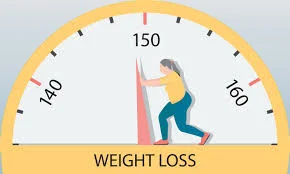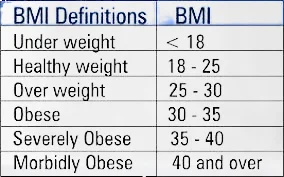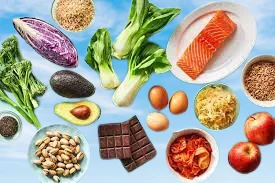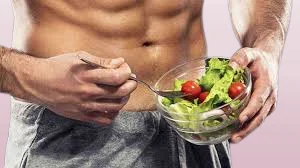How to lose weight: A person whose weight is higher than what is considered to be a normal weight for a given height is described as being overweight or having obesity. Factors that may contribute to excess weight gain among adults and youth include genetics; types and amounts of food and drinks consumed; level of physical activity; degree of time spent on sedentary behaviors, such as watching TV, engaging with a computer, or talking and texting on the phone; sleep habits; medical conditions or medicines; and where and how people live, including their access to and ability to afford healthy foods and safe places to be active.
How to Lose Weight
Overweight and obesity increase the risk for many health problems, such as type 2 diabetes, high blood pressure, heart disease, stroke, joint problems, liver disease, gallstones, some types of cancer, and sleep and breathing problems, among other conditions.

Before considering weight loss journey, it is very important to know about a health parameter which is called as the BMI or Body Mass Index. BMI is a tool or parameter which is used in healthcare sectors for identifying the body weight of a person as “Normal”, “Overweight” or “Obese” according to his height and weight.
What is Body Mass Index
Body mass index (BMI) is a measure of body fat based on height and weight that applies to adult men and women.
BMI Categories:
Underweight = <18.5
Normal weight = 18.5–24.9
Overweight = 25–29.9
Obesity = BMI of 30 or greater

If you have a BMI less than 18.5 (underweight), you may be at higher risk for developing the following conditions:
Malnutrition.
Anemia.
Weakened immune system, which could lead to more frequent infections and illnesses. Osteoporosis. Infertility.
In general, the higher your BMI, the higher your risk for the following conditions:
- Heart disease.
- High blood pressure (hypertension).
- Type 2 diabetes.
- Gallstones.
- Osteoarthritis.
- Sleep apnea.
- Certain cancers, including colon, breast, endometrial and gallbladder.
- Depression and other mental health conditions.
How to Calculate BMI ( Body Mass Index )
You can calculate BMI yourself with these steps:
- Multiply your weight in pounds by 703. ( If you want to convert your weight from KG to Pound, than you can use the conversion calculator here )
- Divide that answer by your height in inches (there are 12 inches in 1 foot).
- Divide that answer by your height in inches again.
For example, a person who weighs 180 lbs. and is 5 feet and 5 inches tall (65 inches total) would calculate their BMI in the following way:
- 180 x 703 = 126,540.
- 126,540 / 65 = 1,946.769.
- 1,946.769 / 65 = 29.95.
Their BMI would be 29.9.
As an alternative you can use the BMI calculator for your easy reference.
Sustainable healthy weight loss is about making changes to your habits and behaviours, by improving your diet and lifestyle, rather than a quick fix. There are some key things to consider when deciding to lose weight.
Choose just one or two things to change first. The key is consistency, so that it becomes a new habit or way of eating.
Make changes that fit best with you and your lifestyle, as you’re more likely to stick to it.
Don’t try and change too much at once. This may lead to overwhelm, which can make you more likely to fail.
1 – Increasing your daily water intake can help with weight loss. Start your day with a large glass of water, before any food, tea or coffee, and then continue to take sips throughout the day.
2 – Having breakfast has been shown to not only help you make better food choices throughout the day, it also better supports your metabolism and blood sugar balancing. Both of these can help with weight loss.
3 – When you eat protein, it takes the body longer to turn it into (blood) glucose than if it was simple carbohydrates – carbs are already a form of sugar. Therefore, having protein every time you eat provides the body with steadier blood sugar control, greater satiety and reduced sugar cravings. This means you’ll eat less throughout the day and lose weight
4 – Chewing is the very first step in the digestive process, but all too often we eat too quickly, especially when we’re distracted. When you don’t chew your food properly, not only does this put extra strain on your digestive system, causing symptoms such as bloating, it also means you’re more likely to overeat as you don’t give the brain time to register when you’re full.
5 – While fats have more calories per gram than protein or carbohydrates, adding more good fats to your diet can help reduce sugar cravings and give greater satiety, thereby supporting healthy weight loss. Good fats include nuts, seeds, oily fish, olive oil and avocado
6 – Don’t skip meals
7 – Walking at a brisk speed for 30 minutes as soon as possible after lunch or dinner leads to greater weight loss for some people than walking for 30 minutes an hour after a meal has been consumed.
8 – Giving your body a break from food is important when it comes to your health and losing weight. Aim to have a minimum 12 hours natural fast between dinner and breakfast.
9 – While life can get busy, opting for wholefoods over those that are processed or ready-made can help with weight loss. Processed and pre-packaged foods often contain less fibre and nutrients while having more calories, salt and sugar, all of which can cause you to eat more throughout the day.
10 – Cut down on artificial sweeteners

11 – Meditation has a number of benefits when it comes to weight loss. Practising meditation daily can help reduce stress and anxiety, allowing you to cope better during the day and not turn to food as a treat or comfort.
12 – Fibre, quite simply, helps fill you up. When you have more fibre in your diet from foods such as fruit, vegetables, wholegrains, beans and lentils, they offer greater satiety. Feeling fuller for longer will make you eat less throughout the day.
13 – Reduce or stop drinking alcohol
14 – Just moving more in your everyday life will help with your weight loss as well as your motivation. Any movement or exercise can release endorphins that allow us to feel happier, as well as helping burn a few more calories. Activities includes walking, housework and gardening.
15 – Aim to include three weight training or resistance training workouts in your week.
16 – When you’re stressed, the body releases cortisol, a hormone which has a direct impact on blood glucose levels. This can contribute to weight gain. So manage your stress.
17 – A 2010 study found that over a 12-week period, individuals who drank a glass of water 30 minutes before a meal lost 44% more weight than those who didn’t.
18 – Omega-3 is an essential fatty acid, which the body cannot make itself. We must get our omega-3 from food, or supplements. Omega-3 is mainly found in oily fish, such as salmon, mackerel, sardines and anchovies, but there are also some plant-based sources, including chia seeds, flaxseeds and walnuts. Adding more omega-3 to your diet appears to help improve metabolism, which in turn helps reduce weight gain.
19 – Having a salad before your meal may aid weight loss. The combination of low-calorie vegetables and fibre can help you feel full and therefore eat less at your main meal.
20 – Aim to include a variety of foods at each meal. To balance your plate and help you lose weight your meals should include:
- a protein source
- fat source
- vegetables
- a small portion of complex carbohydrates, such as whole grains
21 – Vegetables to include more of:
- broccoli
- cauliflower
- spinach
- tomatoes
- kale
- Brussels sprouts
- cabbage
- Swiss chard
- lettuce
- cucumber
- peppers
22 – Diets with adequate protein may also help you reduce cravings and snacking by helping you feel full and satisfied. Healthy protein sources include:
- meat: beef, chicken, pork, and lamb
- fish and seafood: salmon, trout, sardines, and shrimp
- eggs
- plant-based proteins: beans, legumes, quinoa, tempeh, and tofu
23 – Olive oil and avocado oil are great choices for including in your eating plan. Nuts, seeds, olives, and avocados are delicious and healthy additions, as well.
24 – Eating quickly can lead to weight gain over time, while eating slowly makes you feel more full and boosts weight-reducing hormones
25 – Sleep is important for many reasons, and poor sleep is one of the biggest risk factors for weight gain.
26 – Daliya is very rich in fibre and protein. Fibre not only helps in digestion and bowel movements, but also helps in keeping you full which prevents you from bingeing on unhealthy foods. Whereas, protein takes the longest to digest, keeping hunger at bay.
27 – Dahi, curd, or yogurt is a good source of probiotic elements and beneficial bacteria which improves the digestive system and gut health. Good digestion improves better absorption of nutrients which prevents weight gain. The American Dietetic Association also believes curd to be a good fat burner because of its high calcium content.
28 – Sweet potatoes are low in calories and you should definitely replace them with your regular starch-rich potatoes. They are rich in fibre and contain a lot of water which makes them easier to digest and supports in weight loss.
29 – Tomatoes are considered to suppress your appetite and help in weight loss journey. The water and fibre content in this fruit is very high which makes it a “high-volume” food. A study from China Medical University in Taiwan found that women who drank about 250ml of tomato juice per day for two months saw a considerable decrease in body fat and weight. The women changed nothing in their diet and exercise routine except for adding tomato juice.
30 – Triphala flushes out toxins from the body and reduces bloating causing weight loss.
31 – Just like daliya, chickpeas or chana are rich in protein and fibre which aids weight loss. Fibre content keeps you fuller for longer and takes good care of your gut health. Whereas protein satiates your hunger.
In a study, it was found that those people who consumed chickpeas were 53% more likely to have a healthy BMI. Another study has also found that consuming chickpeas every day increased weight loss by 25%.
32 – Moong dal is one of the most popular lentils found all over India. Moong is packed with fibre and protein, both of which are excellent for weight loss.
33 – Vegetable salads, also known as green salads, are precisely what they sound like: salads made mostly of vegetables. While most ingredients are raw, one also throws in some cooked ingredients. These salads mainly contain leafy vegetables like lettuce, baby spinach, kale, rocket, and coriander. Other common ingredients are tomatoes, peppers, cucumbers, onions, carrots, sprouts, and radish.
Vegetable salads are a great source of fibre and antioxidants. It helps you reduce “bad” cholesterol, manage blood sugar levels, boost your immune system, and may reduce your risk of chronic diseases. These salads tend to be served as appetizers or as the meal itself. It best suits people on paleo or vegan diets and help in weight loss.

34 – Fruit salads are an excellent option for a healthy breakfast. However, you can eat them as a snack or dessert after a meal. These salads generally contain fruits like apples, grapefruits, pomegranates, berries, etc. You can also add nuts like walnuts or almonds to these salads for a crunchy texture.
Fruit salads can help improve your gut health and eye health. It also contains anti-inflammatory properties and boosts your energy levels. If you do not add honey and other animal-derived products in the dressing, this salad type can also work for vegans. It also suits people on a paleo diet.
35 – Mixed salads are a mixture of vegetables, fruits, nuts, and whatever other ingredients you want to add. Essentially, they are a combination of different ingredients. You can also add lean meats like chicken to these salads.
Mixed salads improve your bone health, boost your immune system, and may help reduce the risk of diseases like diabetes, cancer, and so on. It’s also good for your skin. These salads are best suited for people on paleo diets. It can be eaten as a meal itself and at any time of the day. However, you should eat this salad at lunchtime for the best results.
36 – One can make protein salads using any of the above types as a base. The main difference is that, in this salad, you’re prioritizing the inclusion of high-protein ingredients. It’s important to include protein in your diet since they’re essential for the body’s functioning. It’s crucial for maintaining your muscle mass and bone health. Without protein, you will feel tired, weak, and your metabolism rate will slow down.
Protein salads also improve the health of your skin and hair as well as help in weight loss. Adding chicken, eggs, nuts, chickpeas, and other foods like that to your salads will help provide your body with the protein it needs. These salads suit paleo diets, low-carb diets, and Atkins diets. Eat this salad as the meal itself at lunchtime.
37 – If you really like to have some weight loss, Include leafy vegetables like spinach, kale or lettuce, fruits, eggs, nut like walnuts, almonds, peanuts, or pistachios ( highly nutritious and rich in fibre, protein, and various vitamins and minerals ), Avocadoes ( contain nutritious ingredients like potassium, fibre, vitamin C, folate, vitamin K, and monounsaturated fats ).
38 – Exercises like walking, jogging, swimming, jumping rope or skipping, cycling and performing Yoga can be really helpful in the weight loss journey.

3 thoughts on “How to Lose Weight, Know Your BMI ( Body Mass Index ), Best Foods and Exercises for weight loss”